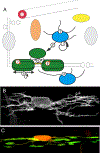Glia as architects of central nervous system formation and function
- PMID: 30309945
- PMCID: PMC6292669
- DOI: 10.1126/science.aat0473
Glia as architects of central nervous system formation and function
Abstract
Glia constitute roughly half of the cells of the central nervous system (CNS) but were long-considered to be static bystanders to its formation and function. Here we provide an overview of how the diverse and dynamic functions of glial cells orchestrate essentially all aspects of nervous system formation and function. Radial glia, astrocytes, oligodendrocyte progenitor cells, oligodendrocytes, and microglia each influence nervous system development, from neuronal birth, migration, axon specification, and growth through circuit assembly and synaptogenesis. As neural circuits mature, distinct glia fulfill key roles in synaptic communication, plasticity, homeostasis, and network-level activity through dynamic monitoring and alteration of CNS structure and function. Continued elucidation of glial cell biology, and the dynamic interactions of neurons and glia, will enrich our understanding of nervous system formation, health, and function.
Copyright © 2018, American Association for the Advancement of Science.
Conflict of interest statement
Competing interests: No competing interests.
Data and materials availability: Not applicable.
Figures




References
-
- Somjen GG, Nervenkitt: notes on the history of the concept of neuroglia. Glia. 1, 2–9 (1988). - PubMed
-
- Dimou L, Götz M, Glial Cells as Progenitors and Stem Cells: New Roles in the Healthy and Diseased Brain. Physiological reviews. 94, 709–737 (2014). - PubMed
-
- Salter MW, Stevens B, Microglia emerge as central players in brain disease. Nat Med. 23, 1018–1027 (2017). - PubMed
Publication types
MeSH terms
Grants and funding
LinkOut - more resources
Full Text Sources
Other Literature Sources
Research Materials

